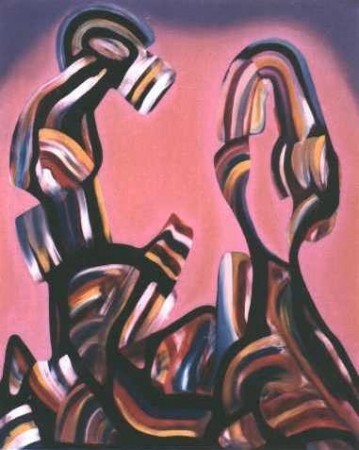Gregg Simpson
Modern Ghosts: Solo exhibition at Richmond Art Gallery, 1986, in Vanguard Magazine
“In the context of the currently fashionable East Village Surrealism, Gregg Simpson’s work has both authenticity and interest. It is based on an in-depth understanding of historical surrealist theory and methods, and is fertilized by his contacts with practitioners of the movement in Europe. But against the broader context of the art of the last twenty years I, it is an anomaly. It is undeniably of its time, yet uncomfortably so. Simpson has kept to the sixties’ idea of art as a process that springs naturally from the process of living without abandoning the medium of paint.
Simpson’ career has intersected some of the most important artistic movements in Vancouver’s history: he was in on the beginnings of the Sound Gallery, Intermedia and The New Era Social Club; he played in the seminal Al Neil Trio; he made collages and video in the early seventies. And yet, unlike many a conceptualist, he has not ‘returned to the object’ for he never left it. He continues to paint and painting and improvised music remain the two media to which he is equally dedicated.
His painting has historical roots in the “abstract surrealism” of Ernst, Paalen, Dominguez and Matta. In this kind of work the painting is a model and demonstration of the process of creation in the natural world. Germinating from a technical idea, a specific operation on the paint, forms proliferate and spread organically across the canvas to build a cosmic or mental landscape. The seed is often an automatism such as frottage or fumage, and Simpson is a master of surrealist techniques. But he doesn’t have to rely on a method for forcing inspiration. In fact Simpson’s output over the last ten years has been large and never ceasing, always branching and dividing into new areas with a momentum of its own.
The works in the current show are divided into two groups. According to the exhibition statement, the oils in the larger gallery are…”a daylight world of substantial phantoms.” In the smaller gallery are a number of acrylics in black and white which “represent a grey, spectral world…of totemic beings.” Expression in these works means animation of the materials. Presences emerge from the generative swirl of the paint. Like living beings from the ground of nature, to confront us with their own gaze.
One can also detect here the proliferating energy of the rainforest, and a distinctly regional attitude toward content. Like Al Neil, bill bissett, Jack Wise, and other friends from the sixties, Simpson combines a sophisticated understanding of modern methodology with a down-home spirituality. There is a sincerity about content in all the artists I’ve mentioned that is definitely not “cool”, but very much west coast. Simpson’s cellular images not only unite the micro and macro cosmic, but also bring forward once again the west coast artist’s desire in front of nature not to represent it, but to become like it in a spirit of affirmation.
Open-ended, spontaneous, somatic, danceable, ephemeral, informal, free-improvised music was really the art form of the sixties, the logical end point of a drive toward an art that happens rather than merely is. To hold this attitude in balance with painting, as Simpson has done, is a rare accomplishment. And now one can see the product of this contradictory activity in paintings that represent in their imagery and demonstrate through their process many of those values associated with the sister art. The motive behind the performance and media-based art of the halcyon era was to break out of the confines of the static object, with its weight of associations, and thereby to let more life into art. Today the object once more reigns supreme. But Simpson has achieved a reconciliation of art and life in a way that was not sought during the sixties, namely within the space of painting.”
Robert Linsley
Vanguard
Dec. Jan. 1987


